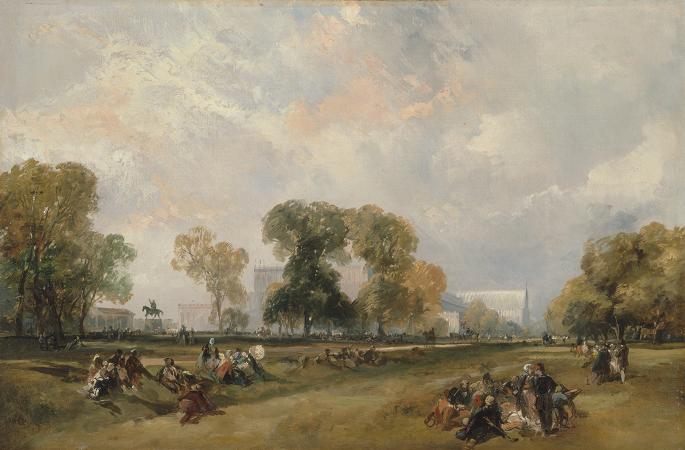Crystal Palace. The Crystal Palace was a cast-iron and plate-glass structure originally built in Hyde Park, London, to house the Great Exhibition of 1851. The exhibition took place from 1 May until 15 October 1851, and more than 14,000 exhibitors from around the world gathered in its 990,000 square feet exhibition space to display examples of technology developed in the Industrial Revolution. Designed by Joseph Paxton, the Great Exhibition building was 1,851 feet long, with an interior height of 128 feet. It was three times the size of St Paul's Cathedral. The introduction of the sheet glass method into Britain by Chance Brothers in 1832 made possible the production of large sheets of cheap but strong glass, and its use in the Crystal Palace created a structure with the greatest area of glass ever seen in a building. It astonished visitors with its clear walls and ceilings that did not require interior lights. It has been suggested that the name of the building resulted from a piece penned by the playwright Douglas Jerrold, who in July 1850 wrote in the satirical magazine Punch about the forthcoming Great Exhibition, referring to a palace of very crystal. After the exhibition, the Palace was relocated to an area of South London known as Penge Common. It was rebuilt at the top of Penge Peak next to Sydenham Hill, an affluent suburb of large villas. It stood there from June 1854 until its destruction by fire in November 1936. The nearby residential area was renamed Crystal Palace after the landmark. This included the Crystal Palace Park that surrounds the site, home of the Crystal Palace National Sports Centre, which had previously been a football stadium that hosted the FA Cup Final between 1895 and 1914. Crystal Palace F.C. were founded at the site in 1905 and played at the Cup Final venue in their early years. The park still contains Benjamin Waterhouse Hawkins's Crystal Palace Dinosaurs which date back to 1854. The huge, modular, iron, wood and glass, structure was originally erected in Hyde Park in London to house the Great Exhibition of 1851, which showcased the products of many countries throughout the world. The Commission in charge of mounting the Great Exhibition was established in January 1850, and it was decided at the outset that the entire project would be funded by public subscription. An executive Building Committee was quickly formed to oversee the design and construction of the exhibition building, comprising Isambard Kingdom Brunel, Robert Stephenson, renowned architects Charles Barry and Thomas Leverton Donaldson, the Duke of Buccleuch and the Earl of Ellesmere, and chaired by William Cubitt. By 15 March 1850 they were ready to invite submissions, which had to conform to several key specifications: the building had to be temporary, simple, as cheap as possible, and economical to build within the short time remaining before the Exhibition opening, which had already been scheduled for 1 May 1851. Within three weeks, the committee had received some 245 entries, including 38 international submissions from Australia, the Netherlands, Belgium, Hanover, Switzerland, Brunswick, Hamburg and France. Two designs, both in iron and glass, were singled out for praise, one by Richard Turner, co-designer of the Palm House at Kew, and the other by French architect Hector Horeau but despite the great number of submissions, the Committee rejected them all. Turner was furious at the rejection, and reportedly badgered the commissioners for months afterwards, seeking compensation, but at an estimated E300,000, his design was too expensive. As a last resort the committee came up with a standby design of its own, for a brick building in the rundbogenstil by Donaldson, featuring a sheet-iron dome designed by Brunel, but it was widely criticized and ridiculed when it was published in the newspapers. Adding to the Committee's woes, the site for the Exhibition was still not confirmed. The preferred site was in Hyde Park, adjacent to Princes Gate near Kensington Rd, but other sites considered included Wormwood Scrubs, Battersea Park, the Isle of Dogs, Victoria Park, and Regent's Park. Opponents of the scheme lobbied strenuously against the use of Hyde Park. The most outspoken critic was arch-conservative Col. Charles de Laet Waldo Sibthorp; he denounced the Exhibition as one of the greatest humbugs, frauds and absurdities ever known, and his trenchant opposition to both the Exhibition and its building continued even after it had closed.
more...





